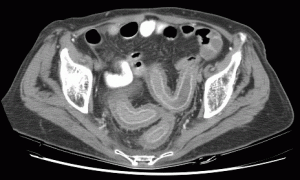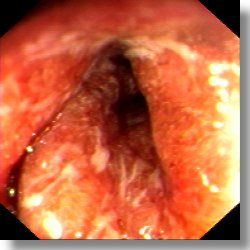Pancolitis is a common inflammatory condition of the intestine that affects around 20-40% of people suffering from Ulcerative Colitis. Learn all about the causes, symptoms, diagnosis, treatment and diet of this disorder.
Pancolitis Definition
Page Contents
It is a very severe inflammation of the entire lining of the colon including right colon, left colon, traverse colon and the rectum. The condition leads to abdominal pain and discomfort that range from mild to acute in intensity. It is a form of Ulcerative colitis, a chronic nonspecific inflammation of the colon which is marked by open sores and ulcers. The condition is also denoted as Universal Colitis and may primarily affect the large intestine. There is a probability of Pancolitis developing into Colon Cancer which depends on the severity and the longevity of the disease.
Picture 1 – Pancolitis
The condition usually develops in adults between 30 and 50 years old but may also arise at an early age.
Pancolitis Causes
The exact causes of the condition are still unrecognizable. However, certain factors have been identified as the probable agents that initiate this type of inflammation.
Autoimmune response or disease
The entry of any foreign body, such as a virus or bacteria, triggers a response from the natural immune system of the body. It is the natural immunity that helps the body to fight a microbial infection. However, there are certain cases where the immune system turns against the digestive bacteria present in the colon while fighting against Ulcerative colitis. This leads to a swelling in the digestive tract. Due to such abnormal functioning of the immune system, even healthy tissues get damaged.
Genetic Predisposition
The genetic makeup of a person also has an impact on the possibilities of having this disorder. Individuals having a family history of Ulcerative Colitis are more prone to this disorder. Children whose parents have been encountered with a similar kind of disease tend to inherit it. Individuals belonging to certain ethnic groups have a greater inclination towards this disorder.
Smoking
Toxins in cigarettes, such as Formaldehyde, Nicotine and Cyanide, irritate the blood vessels lining the digestive tract and may give rise to life-threatening blood clots. Carbon monoxide, present in cigarette smoke, constricts the blood vessels and lowers the amount of oxygen in the bloodstream. It affects firsthand smokers as well as passive smokers.
Environmental determinants
The kind of environment one is staying in also plays a huge role in the development of this disease. It is believed that, there are certain regions in the world especially in the northern parts of Western Europe and America, where the occurrence is reported to be higher.
Certain environmental factors which are responsible for this disease are:
Air pollution
Particulate matter, consisting of soot and aerosol, may cause as well as aggravate inflammation in the gastrointestinal tract. These small matters gain access to the tract through swallowing or secretions from the upper respiratory system.
Diet
High intake of Carbohydrates and fats can increase the severity of inflammation of the epithelial lining in the colon. In comparison, inhabitants of Asian countries are less prone to the disease, owing to their low carbohydrate and fat content diet.
Unsuitable medication
Drugs, such as Accutane, that are used to cure very severe cases of acne can lead to serious side effects in the digestive tract and may cause swelling.
Ulcerative Colitis
This condition is found to have a very close connection with Ulcerative Colitis. Around 16% of the people with Ulcerative Colitis are also found to suffer from Pancolitis.
Pancolitis Symptoms
Patients of this disorder undergo regular episodes of acute symptoms followed by periods of latency. Some of them are:
Abdominal pain
The condition can lead to painful bowel movements. The magnitude of the pain may vary from mild to severe in intensity. Sometimes, convulsions may take place in the abdomen along with bowel movements.
Mucosal Hemorrhage
The disease may lead to the development of small channels of blood clots in the colon. In the course of time, these clots may develop into abscesses. The lesions caused by inflammation may turn lethal and form ulcers.
Picture 2 – Pancolitis Image
Diarrhea
It is a condition marked by frequent bowel movements that lead to extreme dehydration and electrolyte imbalance in the body. In Pancolitis sufferers, Exudative Diarrhea is more common. Such cases of diarrhea hardly respond to over-the-counter (OTC) medications.
Fever
It is predominantly reported in moderate cases where patients may also show signs of anemia due to rectal bleeding.
Fatigue
Patients may encounter physical exhaustion after a prolonged activity. It is characterized by profound lack of energy and muscle weakness.
Weight loss
This is related to diarrhea where there is rapid movement of food through the intestine. On account of this, the large intestine gets very less time to absorb sufficient nutrients and water.
Night sweats
Patients undergo excessive perspiration while sleeping which may or may not happen so abruptly while they are wide awake.
Pancolitis Diagnosis
The diagnosis of this condition is carried out through medical examinations like:
Stool Test
Stool samples are collected in order to eliminate the possibility of infection and parasites causing colitis identical to Pancolitis. Absence of those infections helps in the identification of the disease.
Blood test
Low red blood cell count indicates possibility of anemia. An elevated white blood cell and C- reactive proteins count signifies inflammation in the colon.
Sigmoidoscopy
The process involves examination of the rectum and the sigmoid (distal part of colon) using a Sigmoidoscope – a flexible tube-like apparatus with a camera at one of its ends. This technique helps in viewing intestinal bleeding, inflammation and ulcers. A piece of inflamed tissue can also be removed using instruments inserted into the tube and sent to the laboratory for further examination.
Colonoscopy
It is an endoscopic examination and very akin to Sigmoidoscopy except that the entire colon is examined here. Conditions like bowel movements, mucosal hemorrhage can be explained using this method. Polyps and lesions can be removed using the Colonoscope as small as 1mm or less for further examination. X-ray images of the large intestine reveal only the outline of the colon, making it easier to view gaps or inflammation present in the intestinal wall.
Barium enema X-ray
It is an X-ray examination of the large intestine (colon and rectum) to diagnose any major diseases. It uses a contrast material containing barium which is a soft silvery radio-opaque object, blocking the passage of x-rays. It is inserted into the rectum through the anus using a catheter where it fills the entire colon.
CT & MRI Enterography
These two noninvasive techniques provide more clarity and reveal the minute details of the abdominal area compared to the regular X-ray exams. MRI Enterography involves injection of a contrast medium like Metamucil, barium or Golytely into the body followed by a MRI scan.
CT Enterography combines a CT scan where large amount of contrast medium is orally administered to the patient in order to view the small bowel. It produces multiple images or pictures of the colon. These cross-sectional images can be then examined on a computer monitor.
Pancolitis Treatment
There are varieties of treatments available but none of them can completely cure this disorder. A host of drugs are generally prescribed to the patients, which are administered orally and rectally.
Surgical methods are normally opted for those patients who are at a risk of developing colon cancer and have stopped responding to drug therapy.
Medications
Drugs used for curing this disorder involve:
5-aminosalicyclic acid derivatives
Sulfasalazine, Mesalazine, Olsalazine, Balsalazide are anti-inflammatory drugs used in mild to moderate cases. These drugs help in subsidizing the inflammation and are considered to be very effective.
Tumor necrosis factor (TNF) inhibitors
Infliximab is usually prescribed when conventional therapy yields no result and reduces the need for surgery. These inhibitors are mainly used in severe cases.
Corticosteroids
These are fast acting anti-inflammatory agents which control inflammation but are not very efficacious.
Immunomodulators
Methotrexate and Cyclosporine are commonly used to augment the ability of the immune system to produce antibodies that further aggravates the inflammation. It is useful in moderate to severe cases.
Surgery
Operative procedures used for curing this condition involve surgeries like Colectomy. In this process, the entire colon (including the rectum) is removed. It is conducted through Ileostomy where a surgical opening is made by bringing out the end of the small intestine onto the skin surface. The stool is made to pass out and is collected in an external pouch attached to the skin.
Pancolitis Diet
Though there is not any fixed diet to eliminate this disease completely, some people have been found to stop complaining about the symptoms after undergoing dietary modification.
Dairy products like milk, cheese and butter are very beneficial in controlling this condition. An ideal diet to avoid recurrence of the inflammation should comprise of eggs, fish, nuts, beans, lean meat, vegetables and fruits. Beverages (containing Caffeine) and spicy food should be strictly avoided.
Probiotics, useful bacteria which aid in healthy digestion, can be consumed as part of fermented food such as yogurt and soy yogurt.
In most cases, Pancolitis sufferers usually experience a low grade inflammation and can be effectively treated by medications. It is always advisable to seek medical attention if any of the symptoms is displayed by the person.
References
http://en.wikipedia.org/wiki/Pancolitis
http://www.mayoclinic.com/health/ulcerative-colitis/DS00598/DSECTION=symptoms
http://www.medicinenet.com/ulcerative_colitis/page2.htm
http://symptomsofulcerativecolitis.net/pancolitis/what-is-pancolitis/
http://www.livestrong.com/pancolitis/


